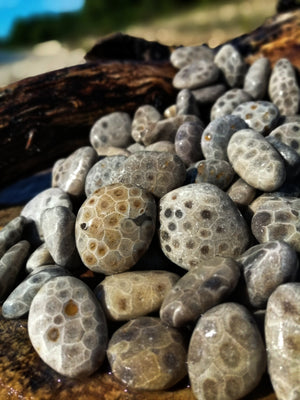What is a Petoskey Stone?
Mar 06, 2024
Nestled along the shores of Lake Michigan, a unique and captivating natural wonder awaits discovery – the Petoskey stone. Renowned for its distinctive honeycomb pattern and rich geological history, the Petoskey stone is more than just a beachcomber's treasure; it's a symbol of Michigan's geological legacy. In this blog, we'll dive into the question of what are Petoskey stones, exploring their formation, significance, and the allure that has captivated collectors and nature enthusiasts for generations.
Formation:
Petoskey stones are fossilized coral specimens, specifically belonging to the Hexagonaria percarinata species, which thrived in the ancient Devonian seas around 350 million years ago. These sea creatures built massive coral colonies, forming intricate structures over time. As the corals died, their skeletons accumulated on the sea floor, eventually becoming fossilized through a process known as lithification.

The hexagonal shapes that define Petoskey stones are remnants of the coral polyps' skeletal structures. Over millions of years, the geological forces at play uplifted these fossilized corals and exposed them to erosion, eventually washing them ashore.
Geographical Origin:
The name "Petoskey stone" pays homage to the city of Petoskey, Michigan, where these unique fossils are particularly abundant. However, Petoskey stones can also be found along the shores of other Great Lakes, including Lake Huron and Lake Michigan, as well as in various inland locations where glacial activity has transported them.
Distinctive Features:
What sets Petoskey stones apart is their characteristic honeycomb pattern, created by the fossilized coral polyps' hexagonal shapes. The stones typically exhibit a light gray or beige color, with the pattern becoming more pronounced when wet or polished. The contrast between the fossilized coral and the surrounding matrix gives these stones a striking and eye-catching appearance.

Cultural Significance:
Petoskey stones hold cultural and historical significance in Michigan, where they are cherished not only for their geological beauty but also for the connection to the region's ancient past. Locals and visitors alike enjoy combing the shores in search of these unique stones, turning the hunt into a popular recreational activity.
Collecting and Crafting:
Beyond their aesthetic appeal, Petoskey stones have become prized collectibles and are often used in jewelry and crafting. Enthusiasts employ lapidary techniques to cut, shape, and polish these stones, revealing the intricate patterns within. From pendants and earrings to keychains and paperweights, Petoskey stone creations offer a tangible connection to the Earth's distant past.
Conclusion:
Petoskey stones stand as testament to the fascinating geological history of the Great Lakes region. Their distinctive patterns, rich backstory, and cultural significance make them more than just beachcombing finds; they are tangible links to an ancient underwater world that continue to captivate and inspire those fortunate enough to encounter them along the shores of Michigan's great lakeshores.

